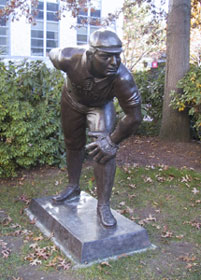 |
 |
|
|
|
|
|
|
|
|
|
|
|
|
|
|
|
|
|
|
|
|
 |
|
Huntington Avenue Grounds: The Pre-Fenway Era Fenway Park has been home to the century-old Red Sox franchise for over 90 years. And while the "lyric little bandbox" is synonymous with Boston Red Sox baseball, few fans know about the predecessor to the current stadium, the ballpark that actually gave birth to the franchise.
The American League began operations in 1901 with eight charter franchises, and with an announcement on January 28 of that year the team that would become known as the Red Sox was officially inducted into the League and the city. The announcement of the team was preceded by Connie Mack's mission to Boston to locate a tract of land within the city that would be used for a ballpark. Mack was about to embark on a career that would gain him notoriety and a place in the Hall of Fame by managing the Philadelphia Athletics for a remarkable 50 years, a time in which he amassed a Major League record 3,731 victories. But first the Massachusetts born Mack made a significant contribution to the Red Sox when he found suitable land owned by the Boston Elevated Railroad on the south side of Huntington Avenue. The plot was located at the intersection of Huntington Avenue and Rogers (present day Forsyth) Street and was in the same neighborhood, but on the other side of the railroad tracks, as the South End Grounds (1871-1915), home of the Boston National League team. The location was 1.5 miles from where Fenway Park would eventually be built. The land was purchased by Charles Somers, a wealthy Cleveland businessman who, at the time of the purchase, was a part owner in the Cleveland franchise in addition to his title of American League Vice President. The first home of the Red Sox was built for $35,000 in 1901. Ground was broken for construction on March 9 and was completed two months later. In between the start and finish of construction, Somers sold his interest in the Cleveland team and became Boston's first official owner. When it was completed, the ballpark dubbed Huntington Avenue Grounds seated 9,000 fans, with room for thousands more standing behind ropes in the outfield and the ample foul territory, where 90 feet separated the stands from the diamond. The initial outfield dimensions were 320 feet down the lines and a daunting 530 feet to center, which was expanded to 635 feet in 1908. The ballyard had only a single entrance with just one turnstile as the team simply known as the Boston Americans won their first home opener on May 8 when Cy Young beat Mack's Athletics 12-4.
As the Boston Americans began to carve out their niche in the sport recognized as the National Pastime, the feats accomplished by the Red Sox franchise in the brief era they played at Huntington Avenue Grounds were responsible for two of the game's most noteworthy firsts. The 1903 team would make history as not only Boston's first champions, but baseball's as well. But before the team left for spring training in Macon, Georgia it was sold to Milwaukee lawyer Henry Killilea. Although he owned the club for only a year, it was one that history recalls fondly for the Red Sox fan. In a year of firsts, May 7, 1903 marked the beginning of the Red Sox-Yankees rivalry. The first game took place at the Huntington Avenue Grounds as 5,000 fans watched Boston beat the Highlanders (or Invaders) 6-2. The team that would eventually change its nickname to the Yankees spent the first two years of their existence as the Baltimore Orioles. Prior to the move to New York they were Boston's main nemesis and the relocation only strengthened the resolve of what remains the most storied and intense rivalry in all of sports. But the most memorable event of 1903 in the annals of baseball history was the beginning of what the press at the time called the "world's series." The first game of the now renowned Fall Classic was played in Boston on October 1 between the Red Sox franchise and the National League's Pittsburgh Pirates. At the time, many did not recognize the American League as an equal to the National League, which began in 1876. As a result, it was no surprise to many that the heavily favored Pirates beat Cy Young in Game 1 by a 7-3 score.
"On October 1, 1903 the first modern World Series between the American League champion Boston Pilgrims (later known as the Red Sox) and the National League champion Pittsburgh Pirates was played on this site. General admission tickets were fifty cents. The Pilgrims, led by twenty eight game winner Cy Young, trailed the series three games to one but then swept four consecutive victories to win the championship five game to three." Boston finished off the best-of-nine series in Game 8 at the Huntington Avenue Grounds on Tuesday, October 13 as 7,455 fans turned out to watch Boston claim the championship with a 3-0 victory behind Bill Dinneen. The famed Honus Wagner struck out to end the series. The next game for the Americans at Huntington Avenue was on April 18, 1904, as 10,000 fans watched two 30-foot pennants raised skyward proclaiming Boston as American League Champions and World Champions. The very next day the team was officially sold to the publisher of the Boston Globe, General Charles Taylor, for $145,000. Taylor turned the team over to his son, John I. Taylor, and a string of meddlesome ownership that ended with Harry Freeze's ouster of Babe Ruth began. Before John I. dismantled the team, Boston won another American League pennant in 1904, but the National League champion New York Giants refused to participate in any post-season activity. As it turned out, the World Series would not be an official, annual event until 1905. By default, the Red Sox repeated as World Champions.
After ending their two-year title run by finishing in fourth place in 1905, Boston slumped to a league worst 49-105 in 1906, the first of three consecutive losing seasons, which were the result of bad baseball judgment from the front office, specifically John I. Taylor. Following another dismal campaign in 1907, Taylor decided the team would start wearing white uniforms with bright red stockings for home games, and as a result, on December 18 Taylor announced the team would be officially known as the Red Sox, the nickname that has identified them ever since. After giving the team its identity, Taylor decided to give them a new home. With the lease for the Huntington Avenue Grounds set to expire following the 1911 season, Taylor decided to build a new ballpark in the Fenway. The move was purely a business decision, as Taylor had already decided to sell the team to James McAleer. Although he would no longer own the team, Taylor would own the new ballpark, which he would rent out to the team's new owner, thus ensuring a financial windfall from the team's sale and continuing profits from rent for years to come. The final game ever played at the Huntington Avenue Grounds was on October 7, 1911 as the Red Sox defeated Washington 8-1. After the Red Sox left, the park was torn down and eventually replaced by the Huntington YMCA, which stood from 1916-53. After Northeastern University acquired the land they built the Cabot Physical Education Center. To this day the site remains a bustling hub of athletic activity for the University. Evidence of the Red Sox' humble origins are etched upon a plaque that dates to May 16, 1956. Visible on the outside wall of the Cabot Center from the sidewalk that runs parallel to Huntington Avenue, the marker notes that the Northeastern University Physical Education Center occupies "The site of the former Huntington Avenue American League Baseball Grounds, on which in 1903 four games of the first World Series were played; The Boston Americans defeated the Pittsburgh Nationals five games to three."
The most visible reminder of the bygone era is the statue of Cy Young that was unveiled on September 23, 1993. Located in the courtyard across from Churchill Hall, the bronze statue sits on what was once the pitcher's mound and exclaims: "At this site in October 1903 baseball's winningest pitcher led Boston to victory in the first World Series." In 11 seasons as tenants of the Huntington Avenue Grounds, the Red Sox franchise finished their tenure with an 850-781 record, eight managers, six nicknames, three owners, and one World Series title.
|




